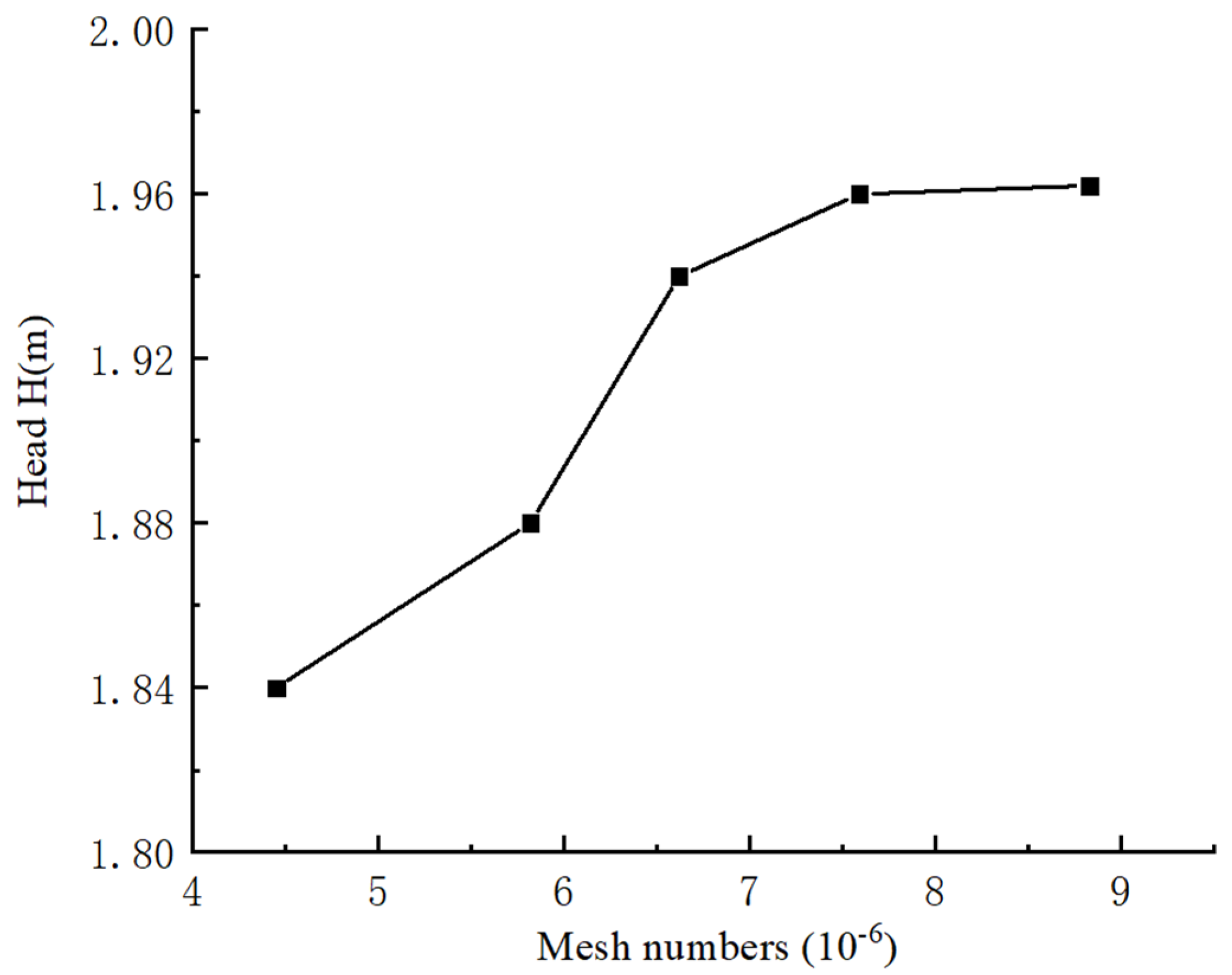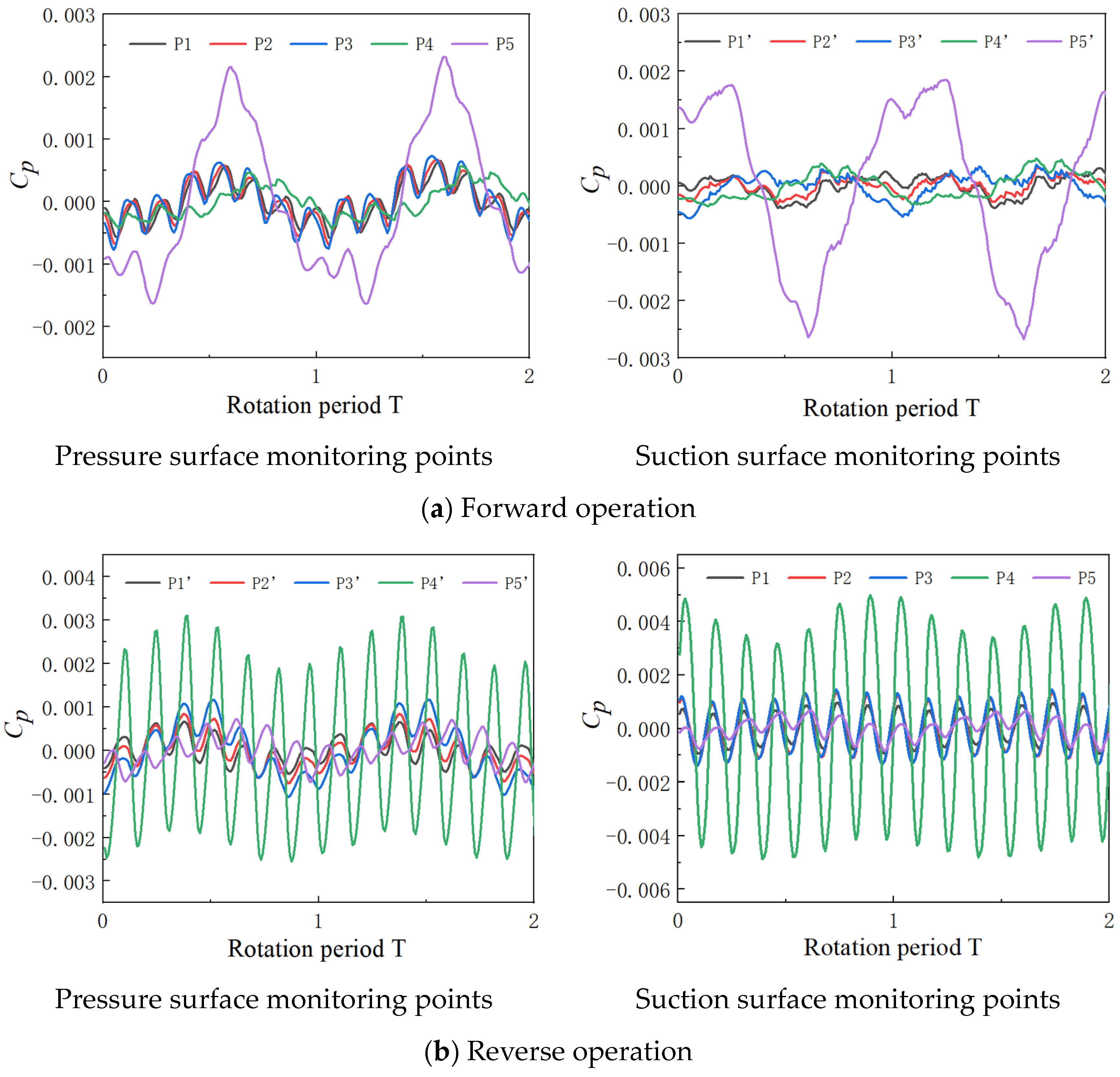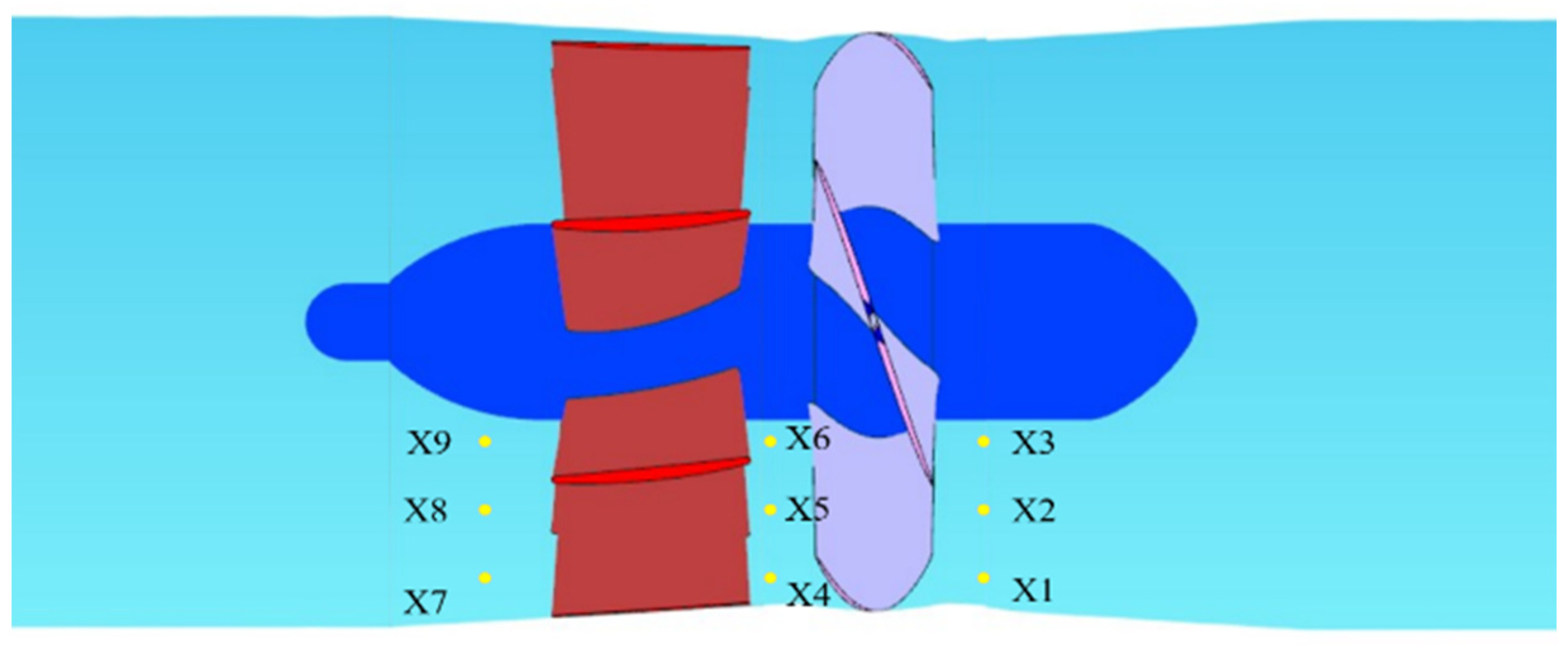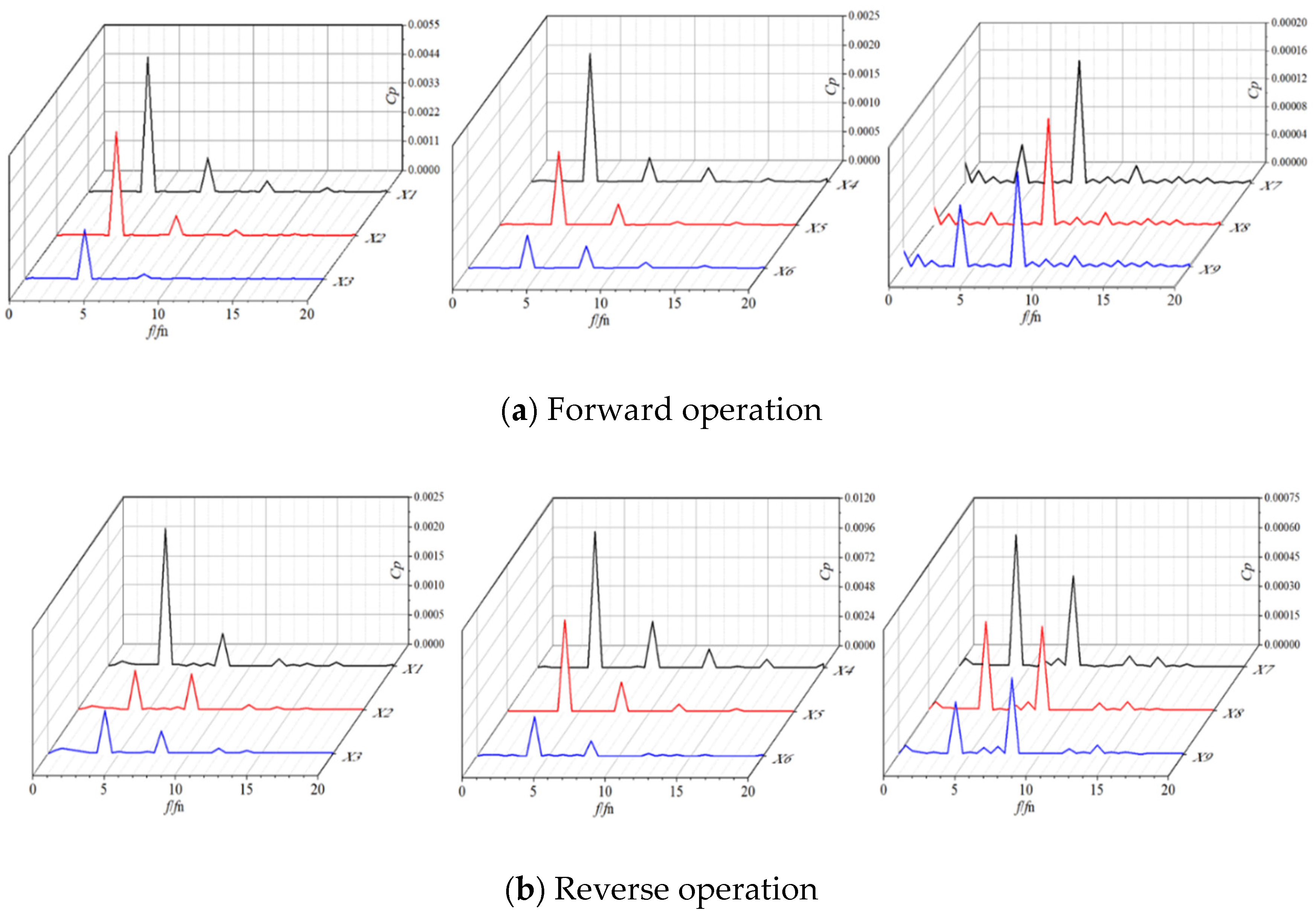Numerical Analysis of Unsteady Internal Flow Characteristics in a Bidirectional Axial Flow Pump
Abstract
:1. Introduction
2. Simulation Model and Numerical Method
2.1. Simulation Model
2.2. Meshing and Validation of Mesh Independence
2.3. Governing Equations and Turbulence Model
2.4. Boundary Conditions
2.5. Physical Model Test Verification
3. Results and Analysis
3.1. Comparative Analysis of the External Performance of the Bidirectional Axial Flow Pump
3.2. Analysis of the Internal Flow Field
3.3. Unsteady Flow Characterization in the Impeller Area
3.4. Analysis of Unsteady Flow in the Pump Device
4. Conclusions
- The bidirectional axial flow pump had different energy characteristics under the forward and reverse conditions. A flow turbulence occurred in the impeller outlet area during the reverse operation, which diminished as the flow rate increased.
- The largest Cp amplitudes in the circumferential and radial directions of the impeller surface were located at the inlet and at the tip of the blade, respectively, which corresponded to the location where the blade was usually damaged. When operating in reverse, the primary frequency of the Cp on the impeller suction surface became the guide vane frequency, which indicated that the suction surface of the impeller was greatly influenced by the front guide vane.
- The FZ and FR of the impeller under low flow conditions were large, so operation under low flow conditions should be avoided as much as possible. The FR amplitude was minimized under the optimal condition. For the same flow conditions, the impeller’s FZ and FR amplitudes were greater in the reverse operation than in the forward operation.
- An analysis of the Cp characteristics of the pumping device under optimal conditions was carried out. Under the reverse operation condition, the impeller inlet area had the largest Cp amplitude, indicating that the dynamic and static interference were aggravated, which could be mitigated by a reasonable hydraulic design of the impeller and guide vane to improve their operational stability.
Author Contributions
Funding
Institutional Review Board Statement
Informed Consent Statement
Data Availability Statement
Conflicts of Interest
References
- Shi, L.; Zhang, W.; Jiao, H.; Tang, F.; Wang, L.; Sun, D.; Shi, W. Numerical simulation and experimental study on the comparison of the hydraulic characteristics of an axial-flow pump and a full tubular pump. Renew. Energy 2020, 153, 1455–1464. [Google Scholar] [CrossRef]
- Liu, C. Researches and developments of axial-flow pump system. Trans. Chin. Soc. Agric. Mach. 2015, 46, 49–59. [Google Scholar]
- Zhu, H.; Bo, G.; Zhou, Y.; Zhang, R.; Cheng, J. Pump selection and performance prediction for the technical innovation of an axial-flow pump station. Math. Probl. Eng. 2018, 2018, 6543109. [Google Scholar] [CrossRef]
- Xu, H. Research on the application of center-opening sectional bi-directional axial flow pumps in low head irrigation and drainage pumping stations. Drain. Irrig. Mach. 2000, 18, 20–23. (In Chinese) [Google Scholar]
- Li, L.; Wang, Z.; Hu, R.; Cen, M. Numerical Simulation of the Influence of Guide Vanes on Tubular Pumping Station Performance in Dual-directional Operation. Trans. Chin. Soc. Agric. Mach. 2007, 38, 76–79. (In Chinese) [Google Scholar]
- Zhang, R. Pump type and arrangement of low-lift two-way drainage and irrigation stations. Water Resour. Hydropower Eng. 1994, 36, 33–38. (In Chinese) [Google Scholar]
- Bozorgi, A.; Javidpour, E.; Riasi, A.; Nourbakhsh, A. Numerical and experimental study of using axial pump as turbine in pico hydropower plants. Renew. Energy 2013, 53, 258–264. [Google Scholar] [CrossRef]
- Liu, H.; Tang, F.; Yan, S.; Li, D. Experimental and numerical studies of cloud cavitation behavior around a reversible S-shaped hydrofoil. J. Mar. Sci. Eng. 2022, 10, 386. [Google Scholar] [CrossRef]
- Ma, P.F.; Wang, J.; Wang, H.F. Investigation of performances and flow characteristics of two bi-directional pumps with different airfoil blades. Sci. China Technol. Sci. 2018, 61, 1588–1599. [Google Scholar] [CrossRef]
- Liu, H.; Tang, F.; Shi, L.; Dai, L.; Shen, J.; Liu, J. The analysis of cavitation flow and pressure pulsation of bi-directional pump. J. Mar. Sci. Eng. 2023, 11, 268. [Google Scholar] [CrossRef]
- Chen, J.; Zhang, H.; Li, Y.; Meng, F.; Zheng, Y. Study on Inflow Distortion Mechanism and Energy Characteristics in Bidirectional Axial Flow Pumping Station. Machines 2022, 10, 1014. [Google Scholar] [CrossRef]
- Kan, K.; Xu, Z.; Chen, H.; Xu, H.; Zheng, Y.; Zhou, D.; Muhirwa, A.; Maxime, B. Energy loss mechanisms of transition from pump mode to turbine mode of an axial-flow pump under bidirectional conditions. Energy 2022, 257, 124630. [Google Scholar] [CrossRef]
- Liu, X.; Xu, F.; Cheng, L.; Pan, W.; Jiao, W. Stress Characteristics Analysis of Vertical Bi-Directional Flow Channel Axial Pump Blades Based on Fluid–Structure Coupling. Machines 2022, 10, 368. [Google Scholar] [CrossRef]
- Ma, P.; Wang, J. An analysis on the flow characteristics of bi-directional axial-flow pump under reverse operation. Proc. Inst. Mech. Eng. Part A J. Power Energy 2017, 231, 239–249. [Google Scholar] [CrossRef]
- Bai, L.; Zhou, L.; Han, C.; Zhu, Y.; Shi, W. Numerical study of pressure fluctuation and unsteady flow in a centrifugal pump. Processes 2019, 7, 354. [Google Scholar] [CrossRef]
- Yang, F.; Chang, P.; Jian, H.; Lv, Y.; Tang, F.; Jin, Y. Numerical analysis of unsteady internal flow characteristics of impeller-guide vane in a vertical axial flow pump device. Front. Energy Res. 2022, 10, 935888. [Google Scholar] [CrossRef]
- Wang, W.; Chen, Q.; Yan, D. Hydraulic stability analysis of a large prototype Francis turbine based on field test. J. Fluids Eng. 2018, 140, 114501. [Google Scholar] [CrossRef]
- Kang, C.; Mao, N.; Pan, C.; Zhou, Y. Turbulent flow characteristics in an axial-flow pump at direct and reverse modes. J. Appl. Sci. Eng. 2016, 19, 447–458. [Google Scholar]
- Zhang, X.; Tang, F.; Chen, Y.; Huang, C.; Chen, Y.; Wang, L.; Shi, L. Experimental study on the internal pressure pulsation characteristics of a bidirectional axial flow pump operating in forward and reverse directions. Machines 2022, 10, 167. [Google Scholar] [CrossRef]
- Kan, K.; Li, H.; Chen, H.; Xu, H.; Gong, Y.; Li, T.; Shen, L. Effects of clearance and operating conditions on tip leakage vortex-induced energy loss in an axial-flow pump using entropy production method. J. Fluids Eng. 2023, 145, 031201. [Google Scholar] [CrossRef]
- Guo, Y.; Yang, C.; Mo, Y.; Wang, Y.; Lv, T.; Zhao, S. Numerical study on the mechanism of fluid energy transfer in an axial flow pump impeller under the rotating coordinate system. Front. Energy Res. 2023, 10, 1106789. [Google Scholar] [CrossRef]
- Wu, D.; Bai, Y. Numerical Simulation of Flow-Induced Noise in Horizontal Axial Flow Pumps in Forward and Reverse Conditions. Water 2023, 15, 322. [Google Scholar] [CrossRef]
- Blazek, J. Computational Fluid Dynamics: Principles and Applications; Butterworth-Heinemann: Oxford, UK, 2015. [Google Scholar]
- Wilcox, D.C. Turbulence Modeling for CFD; DCW Industries: La Canada, CA, USA, 1998. [Google Scholar]
- Strelets, M. Detached eddy simulation of massively separated flows. In Proceedings of the 39th Aerospace Sciences Meeting and Exhibit, Reno, NV, USA, 8–11 January 2001; p. 879. [Google Scholar]
- Cui, B.; Liu, J.; Zhai, L.; Han, A. Analysis of the performance and pressure pulsation in a high-speed centrifugal pump with different hub-cutting angles. Mod. Phys. Lett. B 2023, 37, 2350117. [Google Scholar] [CrossRef]
- Bosioc, A.I.; Susan-Resiga, R.; Muntean, S.; Tanasa, C. Unsteady pressure analysis of a swirling flow with vortex rope and axial water injection in a discharge cone. J. Fluids Eng. 2012, 134, 081104. [Google Scholar] [CrossRef]















| Main Parameter | Value |
|---|---|
| Flow (m3/h) | 360 |
| Head (m) | 1.96 |
| Number of impeller blades, Zi | 4 |
| Number of guide vane blades, Zs | 7 |
| Rotational speed, n (r/min) | 1450 |
| Impeller inlet diameter, D0 (mm) | 200 |
| Inlet diameter, D1 (mm) | 200 |
| Outlet diameter, D2 (mm) | 250 |
| Location | Boundary Conditions |
|---|---|
| Inlet of pump device | Flow |
| Outlet of pump device | Pressure |
| Fluid medium | Water |
| All physical surfaces of pump | No-slip wall, Smooth wall |
| Interfaces on both sides of impeller in steady calculation | Frozen Rotor |
| Interfaces on both sides of impeller in unsteady calculation | Transient Rotor Stator |
| Other computing domain interfaces | None |
| Convergence accuracy | 10−4 |
Disclaimer/Publisher’s Note: The statements, opinions and data contained in all publications are solely those of the individual author(s) and contributor(s) and not of MDPI and/or the editor(s). MDPI and/or the editor(s) disclaim responsibility for any injury to people or property resulting from any ideas, methods, instructions or products referred to in the content. |
© 2023 by the authors. Licensee MDPI, Basel, Switzerland. This article is an open access article distributed under the terms and conditions of the Creative Commons Attribution (CC BY) license (https://creativecommons.org/licenses/by/4.0/).
Share and Cite
Dai, Y.; Shi, W.; Yang, Y.; Xie, Z.; Zhang, Q. Numerical Analysis of Unsteady Internal Flow Characteristics in a Bidirectional Axial Flow Pump. Sustainability 2024, 16, 224. https://doi.org/10.3390/su16010224
Dai Y, Shi W, Yang Y, Xie Z, Zhang Q. Numerical Analysis of Unsteady Internal Flow Characteristics in a Bidirectional Axial Flow Pump. Sustainability. 2024; 16(1):224. https://doi.org/10.3390/su16010224
Chicago/Turabian StyleDai, Yurui, Weidong Shi, Yongfei Yang, Zhanshan Xie, and Qinghong Zhang. 2024. "Numerical Analysis of Unsteady Internal Flow Characteristics in a Bidirectional Axial Flow Pump" Sustainability 16, no. 1: 224. https://doi.org/10.3390/su16010224






